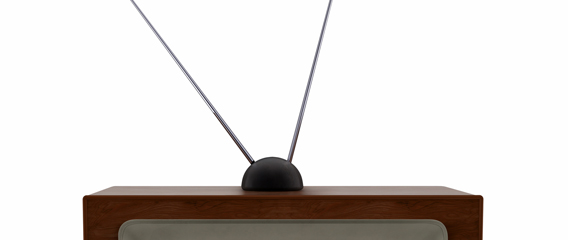In the world of consumer electronics, we often talk about “disruptive” technologies – innovative new products or services that come along, seemingly out of the blue, and forever change or modify the way we live our technological lives. The iPhone is an oft-used example, in that it not only changed the mobile phone market, but also the way we communicate and consume entertainment, but also the way we control our homes.
At an industry talk this past week titled “Technology Today/Tomorrow,” though, consumer electronics industry marketing consultant, author and journalist Michael Heiss made the interesting point that one of the most critical disruptive technologies in recent history is one you might never expect: the rabbit-ear antenna. Yes, I’m talking about the old dome-shaped hunk of plastic that sits above or behind your TV, with two extendable metal rods, designed to yank free TV out of the airwaves and deliver them to your screen.
Mr. Heiss was referring to a dispute between Time Warner Cable and CBS earlier this year, in which the latter blocked the former’s customers from receiving its programming in several major markets as a result of financial disputes. Time Warner Cable’s first inclination was to send its customers to CBS.com to catch up on their favorite shows while the two companies resolved their differeces, but within days even that option was blocked for TWC subscribers.
The ingenious solution? Time Warner Cable offered subscribers in its largest markets free rabbit ears. And the move was such a resounding success that they quickly ran out of antennas.
It seems counterintuitive. Downright anachronistic, in fact. And it’s certainly a change of pace from the days when cable companies were offering a free year of basic cable to entice potential customers who were still holding onto rabbit ears. But as Heiss pointed out in his talk, a good antenna and free over-the-air broadcasts actually have the potential to deliver better picture quality and a more reliable (not to mention free) TV signal than what you’re used to receiving from your local cable or satellite provider. Because, unlike the old analog days of snowy, ghosting over-the-air signals, with high-definition broadcasts the image is either perfect or it’s unwatchable. There really isn’t any middle ground.
That fact is a double-edged sword, though. Whereas in the old analog days you could at least tune into distant, snow-plagued TV stations to catch the World Series – after all, something is better than nothing when it comes to that can’t-miss game – tuning in to HDTV via a set of rabbit ears is an all-or-nothing affair. And rabbit ears may not suffice at all depending on your local geography and broadcast market. You may need one of those big, multi-veined rooftop antennas that positively defined the silhouette of suburbia a generation or two ago.
If you’re tempted by the notion of receiving picture-perfect HDTV broadcasts without paying a monthly bill, though, and don’t want to gamble on potentially buying the wrong antenna for your home or local terrain, there are a couple of resources at your disposal. The Consumer Electronics Association (CEA) and the National Association of Broadcasters (NAB) have developed a website called AntennaWeb.org, which allows you to plug in your home address, peruse a list of free over-the-air stations available to you, and even gives you recommendations on which types of antennas will work best for your location.
But as Time Warner Cable strongly hinted at on its website, your safest bet may be to contact a home technology specialist in your area who has experience with the installation and setup of over-the-air antennas, and who can work with you to ensure that one of the oldest surviving video technologies works best with your modern video entertainment system.
Source: HDLiving.com

